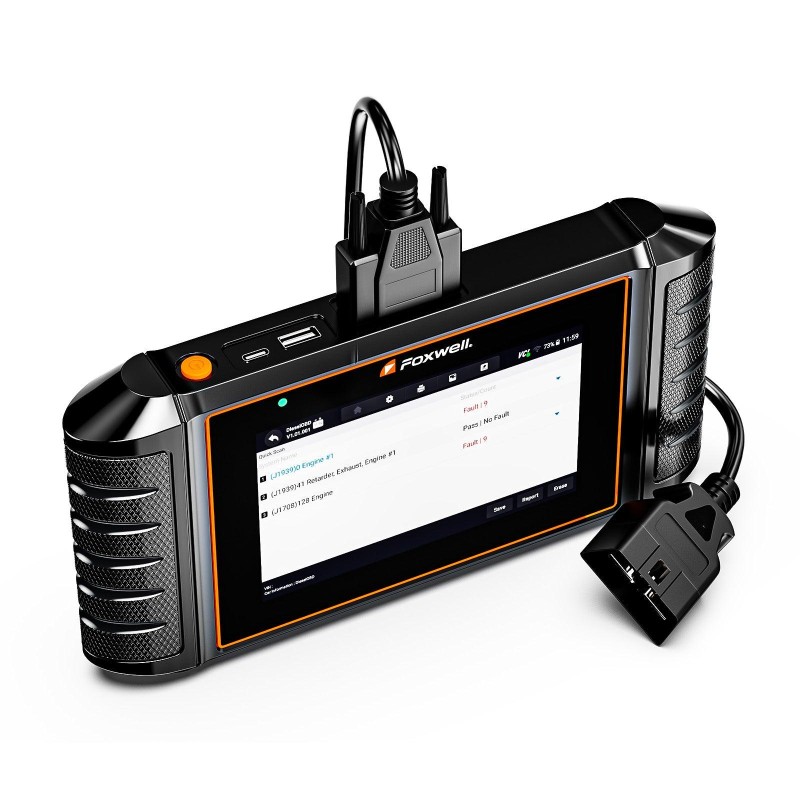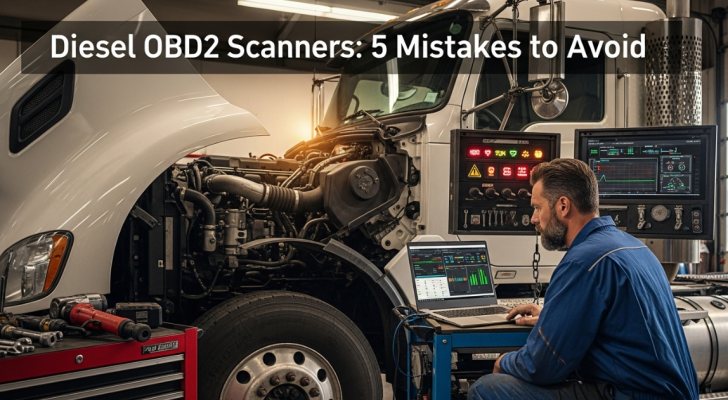- Mistake 1: Ignoring Diesel-Specific Protocols—J1939/J1708 Are Non-Negotiable
- Mistake 2: Settling for “Code Reading Only”—Diesel Needs Specialized Functions
- Mistake 3: Believing “Full Brand Compatibility” Without Checking the Fine Print
- Mistake 4: Overlooking “Lifetime Updates”—New Diesel Models Render Outdated Tools Useless
- Mistake 5: Underestimating “Ease of Use”—Complex Tools Collect Dust
- How to Choose a Diesel OBD2 Scanner That Doesn’t Disappoint
These missteps aren’t just frustrating—they leave critical diesel systems unmonitored, leading to costly repairs or unexpected breakdowns.
The root cause? Confusing “diesel OBD2 scanners” with “standard OBD2 scanners.” Diesel vehicles have unique needs—from heavy-duty communication protocols to specialized maintenance functions—that generic tools simply can’t meet. To avoid these mistakes, you first need to understand what makes a diesel scanner effective. For a complete breakdown of key standards and criteria, Guide to OBD2 scanner for diesel trucks is an essential resource. Below, we break down the 5 most common mistakes to steer clear of, and highlight a tool that checks all the boxes for diesel owners.
Mistake 1: Ignoring Diesel-Specific Protocols—J1939/J1708 Are Non-Negotiable
Most standard OBD2 scanners only support protocols like ISO 9141 or ISO 15765, designed for gasoline vehicles. Diesel trucks and heavy-duty vehicles, however, rely on J1939(the global standard for heavy-duty diesel communication) and J1708(for older diesel models). Without these protocols, a scanner can’t communicate with the vehicle’s ECU—meaning it can’t read critical data, clear fault codes, or perform maintenance functions.
This is where many budget scanners fail: they “support diesel” in name only, but lack the protocols to connect to engines from Cummins, Detroit Diesel, or Paccar. The Foxwell HD500, by contrast, is built for diesel’s unique needs. It fully supports J1939, J1708, and additional heavy-duty protocols like CAN FD and DOIP—ensuring it connects to 2023-model-year Detroit Diesel pickups in seconds, and maintains stable communication with older diesel vehicles too. This protocol coverage isn’t an extra feature; it’s the foundation of a useful diesel scanner, and it’s one of the first criteria highlighted in Guide to OBD2 Scanners for Diesel Vehicles.

Mistake 2: Settling for “Code Reading Only”—Diesel Needs Specialized Functions
A standard OBD2 scanner can read and clear basic fault codes, but diesel vehicles require far more. The biggest pain points for diesel owners—DPF clogging, injector malfunctions, and ABS system issues—demand specialized functionsthat generic tools don’t offer. For example:
- DPF regeneration: Without a tool that can initiate forced regeneration, a clogged DPF leads to reduced power, poor fuel economy, and expensive filter replacements.
- Injector cutoff tests: Identifying a faulty injector requires isolating individual cylinders—something standard scanners can’t do.
The Foxwell HD500 addresses these needs head-on. For DPF maintenance, it doesn’t just monitor soot levels—it lets users initiate forced regeneration, with real-time data tracking to ensure soot levels drop from critical highs (e.g., 85%) to safe ranges (e.g., 12%) without disassembly. For injector issues, its injector cutoff test isolates cylinders to pinpoint malfunctions, avoiding the guesswork that leads to unnecessary part replacements. These functions aren’t “nice-to-haves”; they’re the reason diesel owners invest in a scanner. They’re also exactly the type of features Guide to OBD2 Scanners for Diesel Vehiclesrecommends prioritizing in a diesel-specific tool.
Mistake 3: Believing “Full Brand Compatibility” Without Checking the Fine Print
Many scanner manufacturers claim “universal diesel support,” but reality tells a different story. A tool that works with Ford diesel pickups might fail to connect to Caterpillar (CAT) or Paccar engines—leaving owners of mixed-fleet vehicles with a useless device. This is especially problematic for independent technicians or fleet managers who service multiple diesel brands.
The Foxwell HD500’s compatibility stands out in real-world use. It supports a wide range of mainstream and niche diesel brands, including CAT (e.g., C15 engines), Paccar, International, Hino, Detroit Diesel, Ford, and Ram. Even less common diesel models—those that often fall through the cracks of “universal” scanners—are covered, thanks to its support for niche protocols referenced in Guide to OBD2 Scanners for Diesel Vehicles. This broad compatibility means it works for a single Ford F-250 owner just as well as it does for a fleet manager overseeing CAT and Hino trucks.
Mistake 4: Overlooking “Lifetime Updates”—New Diesel Models Render Outdated Tools Useless
Diesel vehicle technology evolves fast. A scanner that works with 2023 models might not support 2025 models if it lacks software updates. Many manufacturers charge annual fees for updates—turning a “one-time purchase” into a recurring expense. Forgetting to factor in update costs leads to sticker shock later, or worse, a scanner that becomes obsolete within a year.
The Foxwell HD500 eliminates this risk with lifetime free software and vehicle data updates. No annual fees, no “pay-to-unlock” new models—users simply connect to Wi-Fi to sync the latest vehicle data and features. This ensures it stays compatible with 2024, 2025, and future diesel models, protecting the initial investment. As Guide to OBD2 Scanners for Diesel Vehiclesnotes, lifetime updates are a critical marker of a high-value diesel scanner—they turn a tool into a long-term asset, not a short-term fix.
Mistake 5: Underestimating “Ease of Use”—Complex Tools Collect Dust
Diesel scanners don’t need to be overly complicated, but many are. Jargon-heavy menus, confusing setup processes, and lack of clear instructions mean even capable tools get abandoned by owners who can’t figure out how to use them. For DIY diesel owners or technicians who need to work fast, usability is just as important as functionality.
The Foxwell HD500’s plug-and-play design solves this problem. It requires no advanced technical knowledge to set up—users connect the tool to the vehicle’s OBD port, pair it via Bluetooth (if wireless), and select the vehicle make/model. The interface is intuitive, with clear labels for functions like “DPF Regeneration” and “Injector Test,” and it supports 28+ languages for global use. This simplicity doesn’t come at the cost of power; it ensures the tool’s advanced features are accessible to everyone, from first-time DIYers to seasoned technicians. Guide to OBD2 Scanners for Diesel Vehiclesemphasizes this balance—usability ensures a scanner gets used, not left in a toolbox.
How to Choose a Diesel OBD2 Scanner That Doesn’t Disappoint
The key to avoiding these mistakes is to focus on 5 non-negotiable criteria:
1. Diesel-specific protocols: J1939, J1708, and CAN FD/DOIP support.
2. Specialized diesel functions: DPF regeneration, injector cutoff tests, and ABS bleeding.
3. Proven brand compatibility: Coverage for the diesel brands you own or service.
4. Lifetime free updates: No recurring fees, and compatibility with future models.
5. Intuitive design: Easy setup and use for all skill levels.
The Foxwell HD500 meets all these standards—it’s a practical, reliable solution for diesel vehicle owners and technicians who want to avoid the frustration of “bad scanner” experiences. For a deeper dive into how to evaluate these criteria for your specific needs—including how to match a scanner to your vehicle’s make/model and budget—Guide to OBD2 Scanners for Diesel Vehiclesoffers a detailed roadmap.
Don’t waste time or money on tools that promise the world but fail when you need them. A good professional car diagnostic tool should make maintenance easier, not harder—and with the right criteria (and the right tool), you can avoid the most common pitfalls and keep your diesel vehicle running smoothly.
 Editorial staff
Editorial staff

 Editorial staff
Editorial staff


